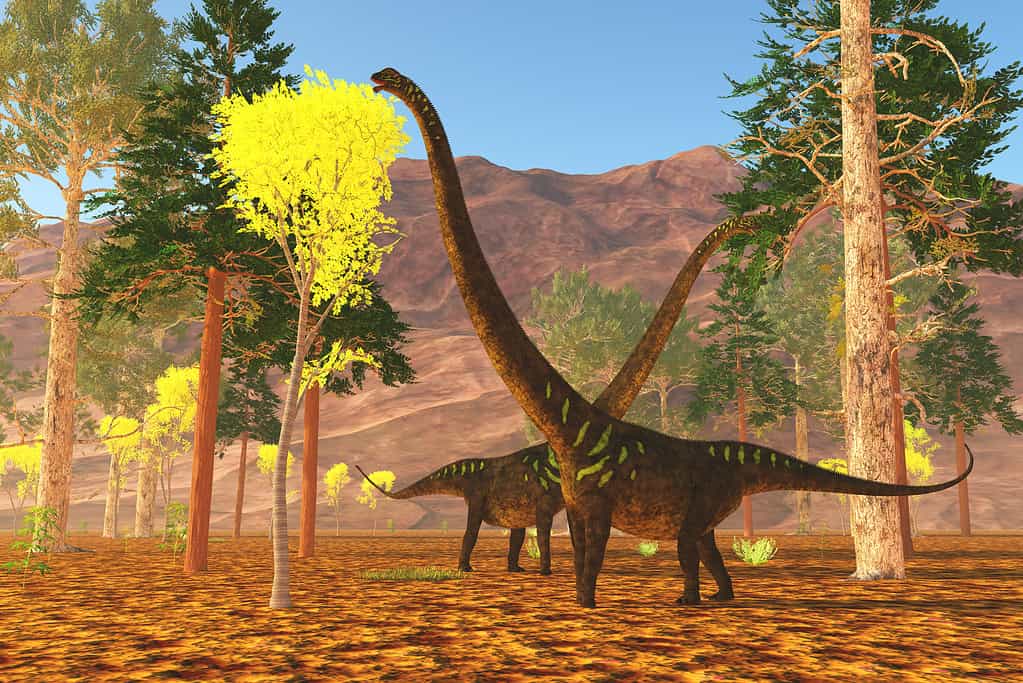
Many herbivorous dinosaurs would roam and eat together.
©CoreyFord/iStock via Getty Images
For millions of years, dinosaurs were roaming the Earth, feeding on whatever the planet offered at the time. Nearly 65% of all dinosaurs found were herbivores. There are over 185 herbivore dinosaur fossils discovered, with more being uncovered every year.
This article highlights some of the most popular herbivore dinosaurs, where they lived, and their special attributes.
Ankylosaurus

This armored dinosaur could smash hip bones with a swing from its tail.
©Orla/iStock via Getty Images
Ankylosaurus magniventris, or the ankylosaurus, translates to “fused lizard.” Some scientists refer to it as a “bent lizard” or “great belly” due to its unique characteristics. It lived during the late Cretaceous era, 68-66 million years ago.
Ankylosaurus roamed across the western plains of North America. Experts have discovered fossils on nearly every continent but Africa and Antarctica. They loved warm, subtropical, and temperate climates and grazed on large plants to sustain their size. A fully-grown ankylosaurus would have been 20-33 feet long and weighed four to eight tons.
Ankylosaurus are easily identified by their armored carapace and large club tail. These plates (osteoderms) covered their entire back, head, and eyebrows, protecting them from predators.
However, their underside does not have covering, making it vulnerable to attacks if flipped over. The ankylosaurus was low to the ground and difficult to topple. Their club proved an invaluable offensive weapon to deter predators. Scientists suspect predators avoided confronting ankylosaurs similar to how wolves avoid porcupines and skunks; the prey was too difficult to hunt and would lead to injury.
The ankylosaurus was first discovered in 1906 by Barnum Brown in Gilbert Creek, Montana. The largest fossil to date is CMN 8880 of an ankylosaurus skull. A large fossil of an ankylosaurus tail is available for viewing at the American Museum of Natural History.
Brachiosaurus
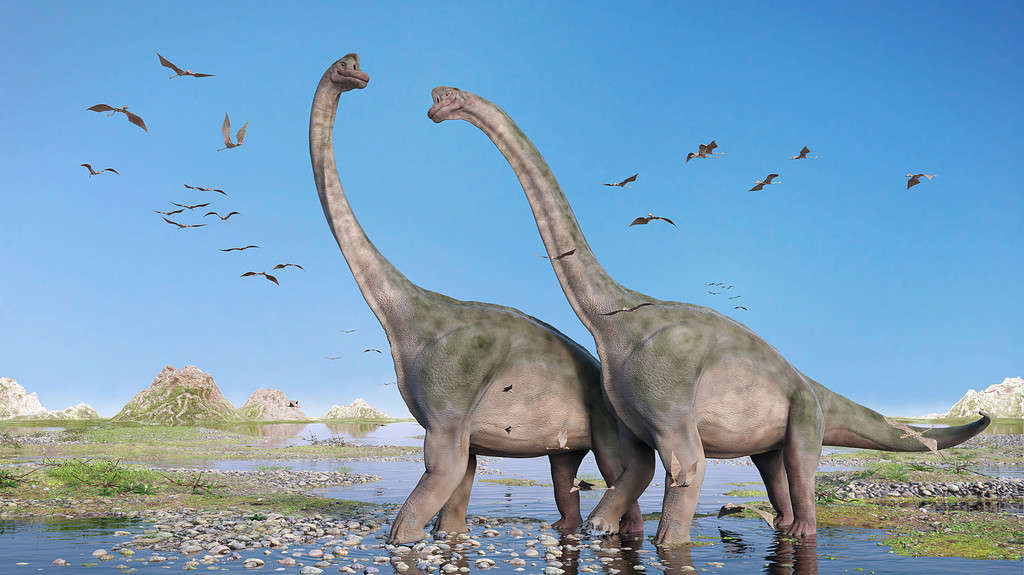
Sauropods lived in groups to keep safe from predators, despite their large size making them hard to kill.
©dottedhippo/iStock via Getty Images
The brachiosaurus (Brachiosaurus altithorax) name translates to “arm lizard.” The Brachiosaurus and other sauropods are the most well-known herbivorous dinosaurs because of their long necks and massive bodies.
Elmer Riggs first discovered a brachiosaurus fossil in 1903 at the Grand River Valley in West Colorado. Upon discovering the fossil, he noticed it had longer front arms than other sauropods.
Like other sauropods, brachiosaurus was a very tall and heavy animal, reaching over 60-85 feet long, 30-40 feet high, and weighing 28 tons.
Brachiosaurus lived in the Jurassic era, 156-145 million years ago. Fossils of brachiosaurus are found across the North American Midwest. Scientists suspect they traveled in herds and lived with many other herbivores of different species. Brachiosaurus fossils indicate they might have eaten rocks to help break down cellulose in plants, but teeth records contradict the theory, highlighting they could chew their food.
Triceratops
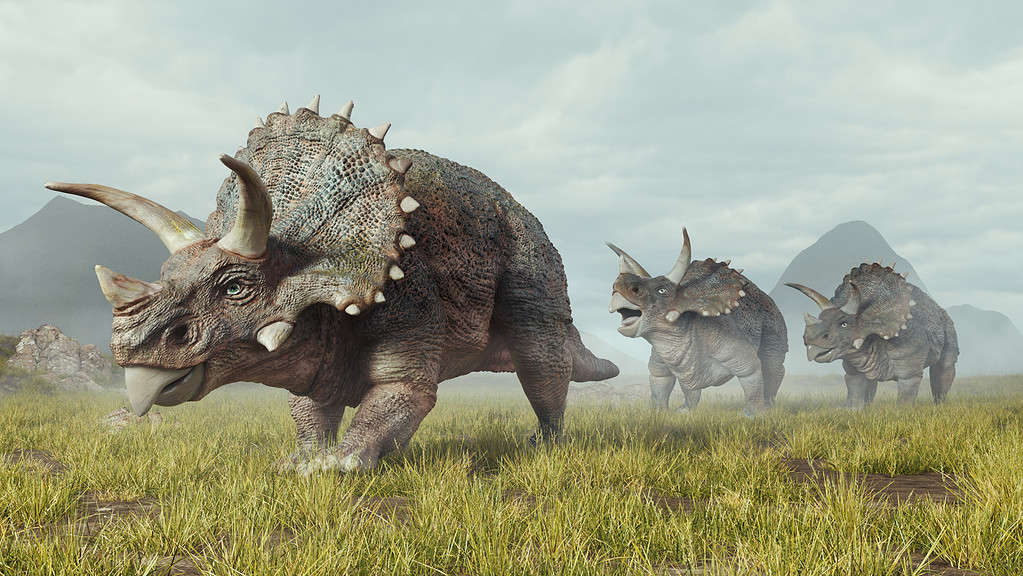
A herd of triceratops could chase away giant predators.
©ALLVISIONN/iStock via Getty Images
The triceratops name translates to “three-horned face.” The triceratops is the second most well-known herbivorous dinosaur because of its unique head shape with three, sharp horns on a large quadruped. People often equate them to prehistoric rhinos, despite the species being unrelated.
The triceratops lived in the late Cretaceous period, 68-66 million years ago. They roamed across the Midwest sections of North America, with fossils being found across Colorado, Montana, and Utah. Fossil records indicate that triceratops lived in herds to protect themselves and their young from predators. However, other fossils show triceratops lived by themselves.
The triceratops were 30 feet long, 9 to 10 feet tall, and weighed around 13,000-26,000 pounds. Skull records show they could go through 800 teeth throughout their life from eating plants and vegetation.
George Lyman discovered the first triceratops fossils in 1877 in Denver, Colorado.
“Big John” is a 26-foot triceratops fossil to date. The specimen is available for viewing at the Lazer’s Children’s Museum in Tampa, Florida.
Stegosaurus
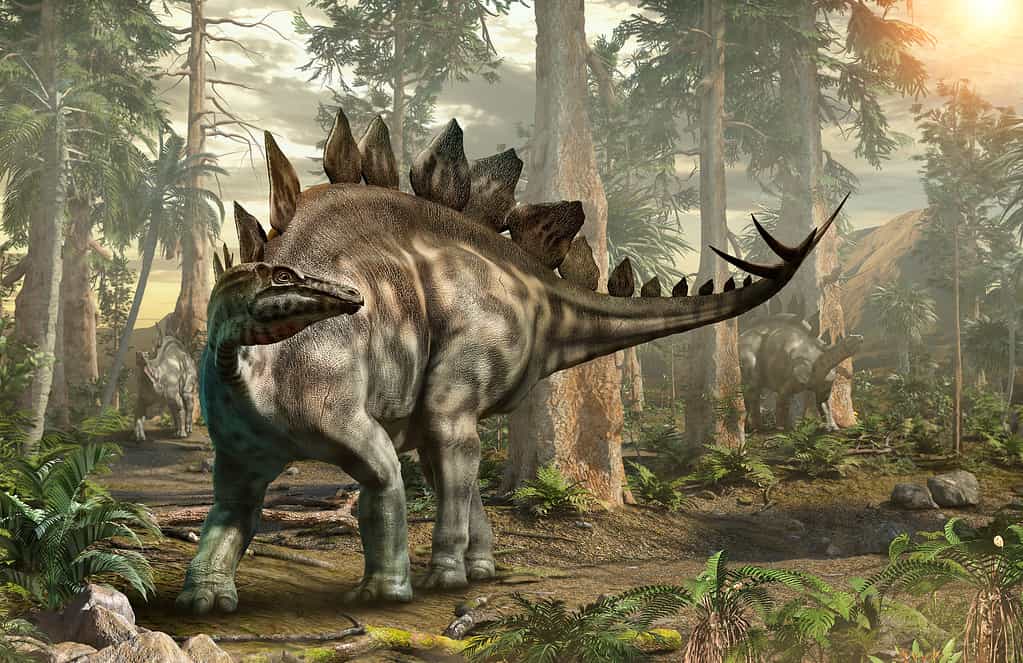
A stegosaurus tail spike can easily pierce skin and break bones.
©Warpaintcobra/iStock via Getty Images
The stegosaurus name translates to “roof lizard.” Originally, paleontologists believed the plates on a stegosaurus’ back laid flat. Further research proved the plates stood vertically instead of horizontally.
Stegosaurus lived in the late Jurassic period, 159-144 million years ago. They were moderately large animals in comparison to sauropods and triceratops, being 9 to 13 feet tall, 30 feet long, and weighing 5.5 tons.
Stegosaurus loved arid environments with plenty of dry leaves and a steady stream of fresh water. Paleontologists find stegosaurus fossils across North America, Europe, and some parts of China.
The stegosaurus is the third most easily identifiable herbivorous dinosaur because of the unique plates lining their back and spikes at the end of their tails. Paleontologists speculate the kite-shaped plates helped regulate body heat, while others suspect they helped attract mates. Because of their thick and uncovered bodies, their spike tails were their best defense against predators.
Another unique attribute of stegosaurus was how they possessed a secondary brain near their hind limbs. A stegosaurus’ head was too small to contain a brain large enough for complex thoughts or control of all of its body’s mechanical functions. The species evolved a secondary brain to help control their hind leg movements.
The Bone Wars of 1877 led to the discovery of the first stegosaurus fossils. Three different types of stegosaurus bones had different plates and shapes lining their body.
Iguanodons
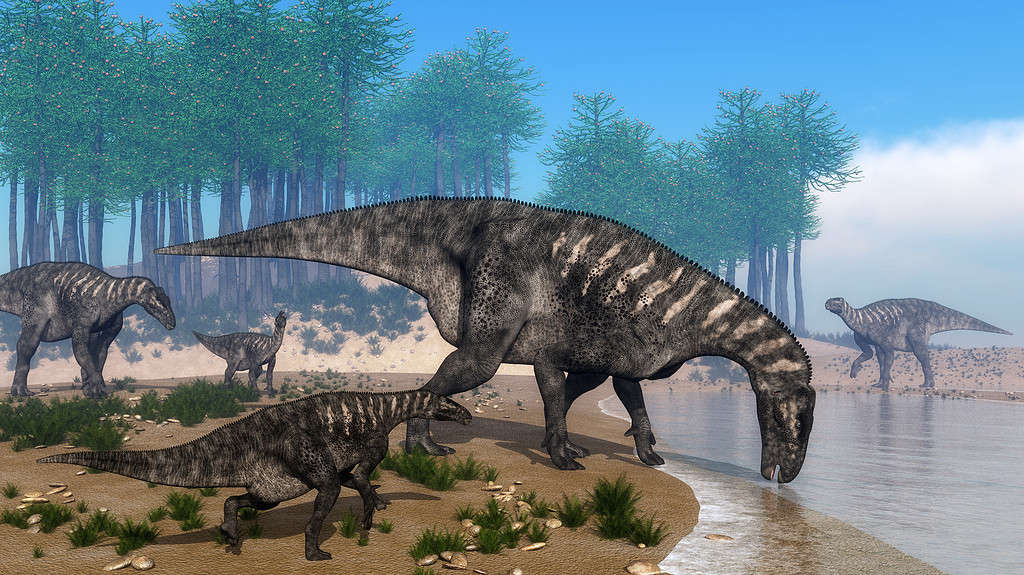
These dinosaurs could stand and walk on their hind limbs to reach food.
©Elenarts108/iStock via Getty Images
The iguanodon’s name translates to “iguana teeth,” which reflects the iguana-like teeth they possessed to chew their food.
Iguanodons lived in the late Jurassic and early Cretaceous eras, 161-99.6 million years ago. They were 8.9 feet tall, 33 feet long, and weighed 8,800 to 11,000 pounds.
The first iguanodon fossils were discovered in 1878 in a coal mine in Belgium. More fossils show that these dinosaurs lived across Europe, Africa, Asia, and North America, feeding off various plants in forests, swamplands, and islands.
Iguanodons had five-fingered hands, including a large thumb spike to help them forage for food. Paleontologists suspect they could walk on all four limbs if desired. They also theorized iguanodons had long tongues to match the size of their skulls.
Interestingly, astronomers named a meteor after the dinosaur. The 9941 Iguanodon is a stray meteor that orbits between Mars and Jupiter.
Apatosaurus
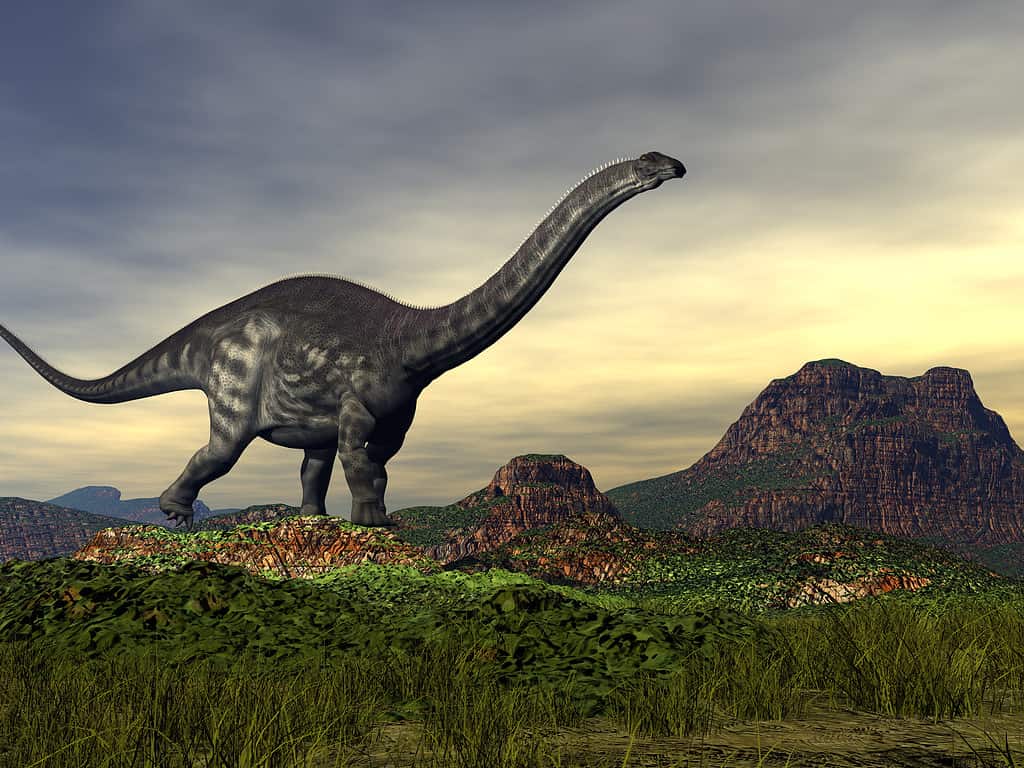
These dinosaurs were too big to live in forests, living alongside riverbanks to feed.
©Elenarts108/iStock via Getty Images
The apatosaurus name translates as “deceptive” or “false lizard” because it fooled paleontologists for many years. Originally, fossils of apatosaurus and brontosaurus were grouped the same. When looking closer at the two species, scientists realized they were both sauropods, but had uniquely different characteristics and many brontosaurus fossils were actually apatosaurus. Apatosaurus has thicker and lower necklines than brontosaurus and other sauropods.
Apatosaurus lived in the late Jurassic period, 147-137 million years ago. They roamed across North America, feeding on tall trees and stripping the branches bare. These sauropods were 16 feet tall, 70-90 feet long, and weighed 40 tons. Incidentally, they were too big to navigate through dense forests, so they lived along riverbanks and open areas with plenty of tall vegetation.
The largest apatosaurus fossil is Louise, named after Andrew Carnegie’s wife. Andrew Carnegie discovered the massive fossil, along with others in 1899.
Parasaurolophus
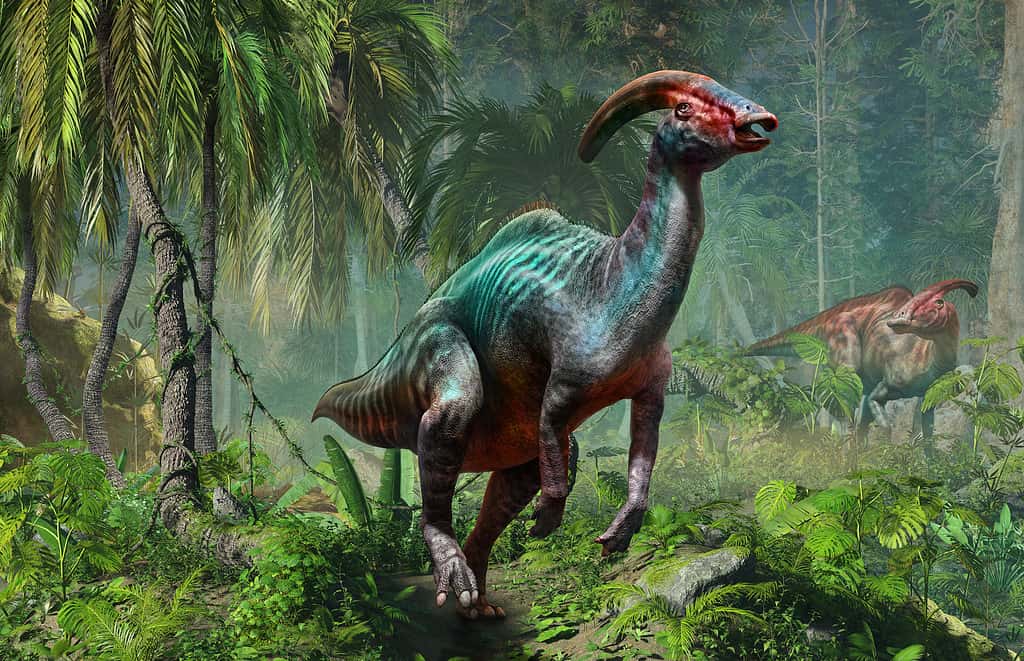
Parasaurolophus and close relatives to the duck-billed dinosaur.
©Warpaintcobra/iStock via Getty Images
The parasaurolophus name translates to “near crested lizard.” This dinosaur is part of the Hadrosaur family, having genetic similarities to the commonly known hadrosaur, the duck-billed dinosaur.
Parasaurolophus lived in the late Cretaceous era, 98-65 million years ago. Like iguanodons, they were capable of walking on all four limbs or standing on their hind legs to reach food. They were 15 feet tall, 33 feet long, and weighed three to four tons.
Parasaurolophus migrated across North America, feasting on plants and trees in forests, swamps, and marshes. They traveled in herds to protect themselves from predators and lived alongside other herbivores in peace.
Paleontologists speculate the purpose of their head crest. Some suggest it was a means of communicating with herd members, releasing a low-frequency sound. Elephants and whales use similar low frequencies to communicate long distances.
The largest parasaurolophus is “P. walker” reaching 31 feet long. The specimen was discovered at Dinosaur Park Formation in Alberta, Canada.
Styracosaurus
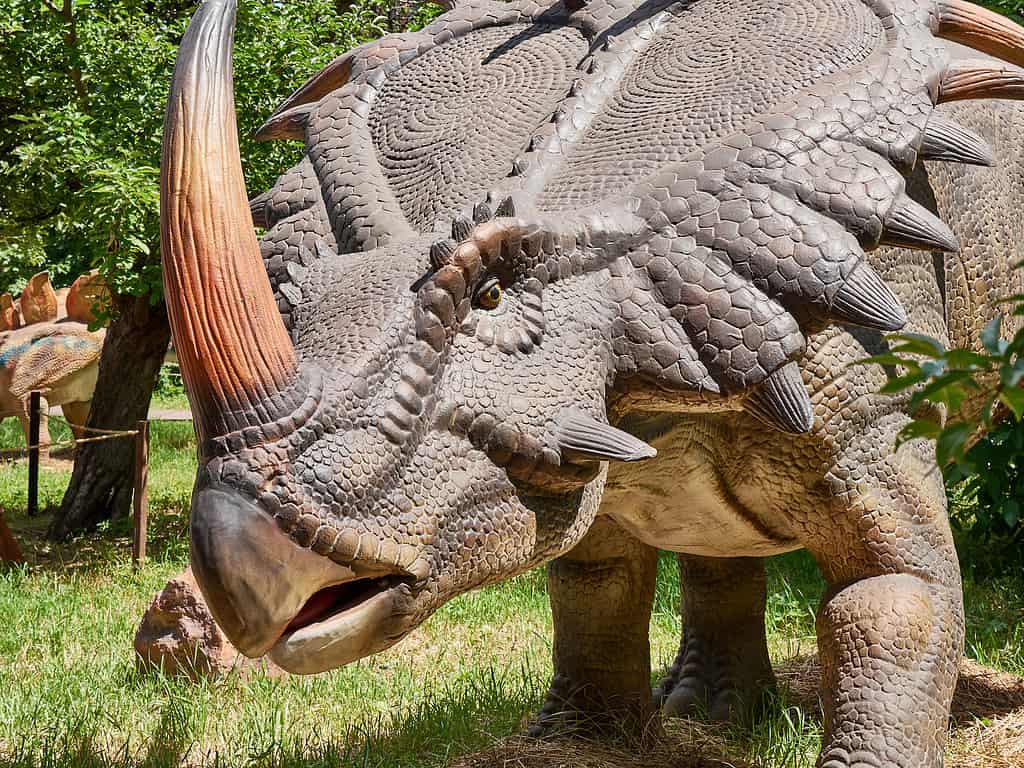
Predators knew to stay away from herds of styracosaurus and their long horns.
©VASYL MYKHAILENKO/iStock via Getty Images
Styracosaurus’s name translates as “spike lizard,” which is impressive considering there are other dinosaurs more famously known for having spikes. Regardless, styracosaurus looks similar to triceratops, except it has one nasal horn instead of three, with long spikes lining the crest across its head.
Styracosaurus lived in the Cretaceous era, 83-70 million years ago. They were much shorter than their triceratops cousins, being 6 feet tall, 18 feet long, and weighing 2.7 tons.
Fossil records indicate styracosaurus lived across North America, with herds living in Canada, Utah, Montana, and Colorado. Evidence shows styracosaurus living in several parts of Europe as well. Additionally, relatives of ceratopsians (dinosaurs like triceratops and styracosaurus) have been found in Asia too.
The unique fan on the dinosaur’s head protected them from predators and helped attract mates similar to deer antlers. They also aided in communication and regulating body temperature. The fan would absorb sunlight, keeping the animal warm, as well as venting excess heat to keep cool.
Styracosaurus was first discovered in 1913 by Lawrence Lambe. The largest fossil ever discovered is the AM 5372 specimen found in Alberta, Canada.
Camarasaurus

Herds of camarasaurus would graze on trees, tripping branches bare before moving on.
©MR1805/iStock via Getty Images
Camarasaurus’s name translates as “chamber lizard,” referencing the hollow vertebra in the dinosaur’s neck.
The camarasaurus lived in the Jurassic period, 161-146 million years ago. It was 59 feet long and weighed 50,000 to 60,000 pounds.
Camarasaurus looked like other sauropods of the era, having a long neck, small head, and massive legs to reach the top of trees to feed on leaves. However, the camarasaurus was smaller than other sauropods and possessed hollow vertebrae. Fossils of camarasaurus indicate the species were gastroliths, swallowing rocks to digest food in their stomachs.
It lived in large herds and traveled across North America, with many fossils found in Utah, Nebraska, New Mexico, and Montana. Paleontologists suspect the camarasaurus was the most common sauropod in the Jurassic era.
The largest camarasaurus fossil ever discovered is CM 11338, which is on display at the Carnegie Museum of Natural History in Pittsburg, Pennsylvania.
Pachycephalosaurus
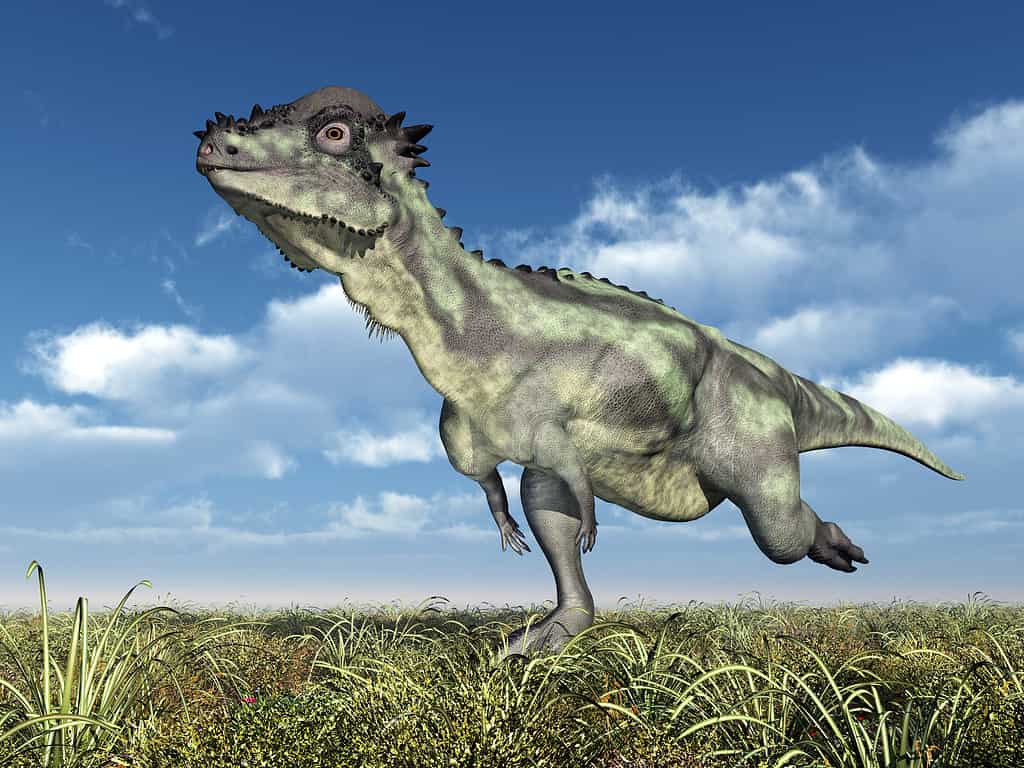
This dinosaur did not use its front arms for defense or combat, but to help forage for food.
©MR1805/iStock via Getty Images
Pachycephalosaurus’s name translates to “thick-headed lizard,” referring to the large bald spot on its head made of bone. They used this hard covering to ram into other dinosaurs or rivals during mating season.
Living during the late Cretaceous era, 100-65.5 million years ago, pachycephalosaurus was deceptively heavy for its size. It was 6 feet tall, 14 to 16 feet long, and weighed 990 pounds. Its long tail helped it maintain balance while walking on its two hind legs. Pachycephalosaurus roamed across subtropical and warm environments across North America.
Currently, there are 30 different pachycephalosaurus specimens. Ferdinand Vandiveer discovered the first fossils in 1859 and 1860 in Hayden, Montana. Vandiveer originally believed their skulls to be protected kneecaps before more research proved otherwise.
Pachycephalosaurus are a type of ceratopsian, meaning they are related to triceratops and styracosaurus.
Albertadromeus
Currently, Albertadromeus is the smallest herbivorous dinosaur ever discovered. Its name translates to “Alberta runner with fused foot bone” because of the dinosaur’s foot development and the location of its discovery, Alberta, Canada.
Albertadromeus lived during the Cretaceous era, 83-72 million years ago. It was 2-3 feet high, 5 feet long, and weighed 30-35 pounds. They scurried across lush forest floors, thriving in subtropical environments across North America. Fossil records indicate they mostly ate plants but could have eaten insects to supplement their diet.
Despite their small stature, they are closely related to hadrosaurs and iguanodons. The only known specimen found is Albertadromeus syntarsus.
Supersaurus
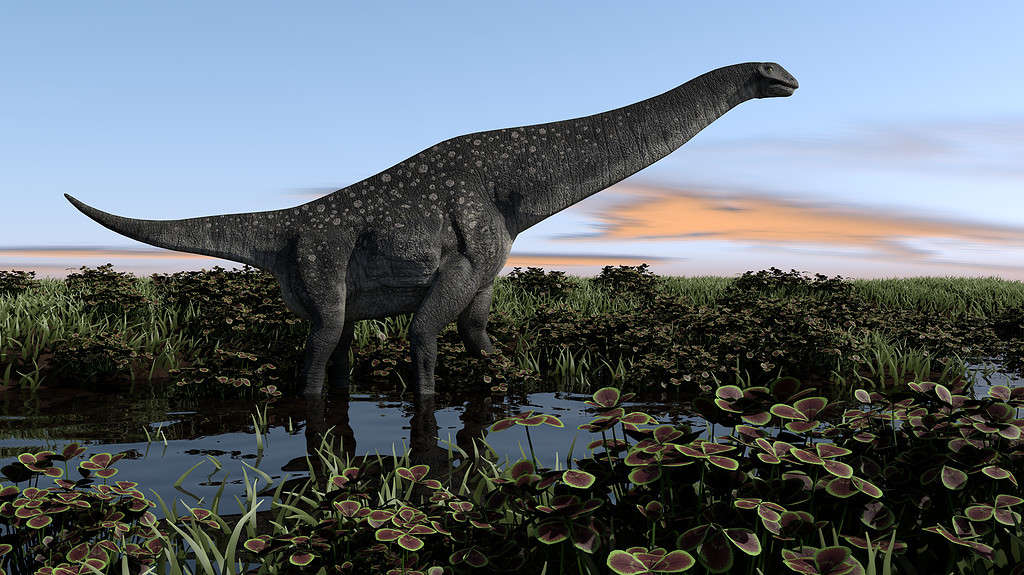
The Titanosaur is smaller than Supersaurus but weighs more at 77 tons.
©Kost/iStock via Getty Images
Finally, supersaurus is the largest herbivorous dinosaur to ever exist. Its name translates as “super lizard” indicating its massive size compared to other sauropods of the species.
Supersaurus lived in the late Jurassic period, 155-145 million years ago. It was a towering 54 feet tall, 108-130 feet long, and weighed 35-40 tons. It also had a 39-foot neck! Surprisingly, supersaurus weighed less than other giant sauropods, but was much longer from head to tail.
This super lizard roamed across grasslands of North America and Europe. Many fossil records are on display in museums around the world, confirming its massive size. Unfortunately, only partial skeletons have been found, with modern technology used to supplement the rest of the body.
The largest supersaurus fossil ever found is Supersaurus vivianae, first discovered by Vivian Jones in the Morrison Formation of Colorado in 1972. Another fossil, DJM-021 or Jimbo, is on display at the Wyoming Dinosaur Center with 30% of its skeleton recovered.
While many other herbivores are still waiting to be found, the ones that have been discovered highlight the amazing versatility and unique adaptive natures of herbivorous dinosaurs.
The photo featured at the top of this post is © Daniel Eskridge/iStock via Getty Images
Thank you for reading! Have some feedback for us? Contact the AZ Animals editorial team.







